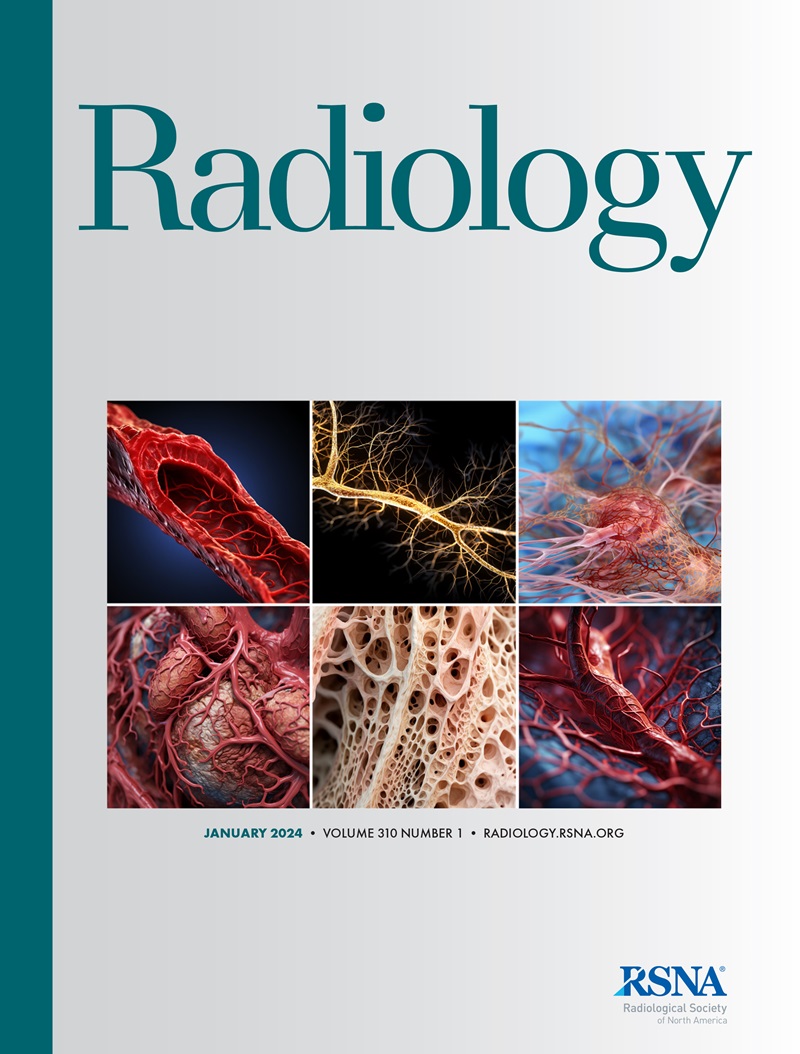Upasana U Bharadwaj, John A Lynch, Gabby B Joseph, Zehra Akkaya, Michael C Nevitt, Nancy E Lane, Charles E McCulloch, Thomas M Link
下载PDF
{"title":"膝关节内注射和膝关节骨性关节炎的进展:来自骨关节炎倡议的数据。","authors":"Upasana U Bharadwaj, John A Lynch, Gabby B Joseph, Zehra Akkaya, Michael C Nevitt, Nancy E Lane, Charles E McCulloch, Thomas M Link","doi":"10.1148/radiol.233081","DOIUrl":null,"url":null,"abstract":"<p><p>Background At least 10% of all patients with knee osteoarthritis (OA) undergo treatment with injectable corticosteroids or hyaluronic acid (HA). Although both have been shown to help with symptomatic pain relief, their long-term effects on knee OA progression remain inconclusive. Purpose To investigate the association between intra-articular knee injections, specifically corticosteroids and HA, and OA progression using a detailed whole-joint semiquantitative MRI evaluation and clinical outcomes for a period of 2 years. Materials and Methods This secondary analysis uses data from the Osteoarthritis Initiative (OAI), a multicenter, longitudinal, prospective study (February 2004 to January 2015). Participants who received a reported injection of corticosteroid or HA and propensity-score-matched controls (on age, sex, body mass index [calculated as weight in kilograms divided by height in meters squared], and clinical variables) were analyzed. Using the Whole-Organ MRI Score (WORMS) system for cartilage, bone marrow lesions, and meniscus, 3-T MRI performed at the time of injection, 2 years prior, and 2 years after were semiquantitatively graded. Postinjection progression was quantified using WORMS difference between time of injection and the 2-year follow-up. Associations with injection type were analyzed using repeated measures of analysis of covariance. Results There were 210 participants analyzed (mean age, 64 years ± 7.9 years [SD]; 126 female participants). Corticosteroids were associated with greater WORMS progression compared with controls (mean difference, 0.39; 95% CI: 0.05, 0.75; <i>P</i> = .02) and HA (0.42; 95% CI: 0.01, 0.84; <i>P</i> = .04). HA was associated with decreased WORMS progression compared with the injection-concurrent time frame (mean difference, -0.42; 95% CI: -1.34, -0.28; <i>P</i> = .003). Both corticosteroids (mean difference in Western Ontario and McMaster Universities Osteoarthritis Index scores, -5.20; 95% CI: -6.91, -3.48; <i>P</i> = .001) and HA injections (-2.15; 95% CI: -4.42, -0.13; <i>P</i> = .04) were associated with reduced pain after injection. Conclusion Corticosteroid injections were associated with higher OA progression than HA injections and controls, whereas HA was associated with decreased progression at MRI for up to 2 years after injection. ClinicalTrials.gov Identifier: NCT00080171 © RSNA, 2025.</p>","PeriodicalId":20896,"journal":{"name":"Radiology","volume":"315 2","pages":"e233081"},"PeriodicalIF":15.2000,"publicationDate":"2025-05-01","publicationTypes":"Journal Article","fieldsOfStudy":null,"isOpenAccess":false,"openAccessPdf":"https://www.ncbi.nlm.nih.gov/pmc/articles/PMC12127947/pdf/","citationCount":"0","resultStr":"{\"title\":\"Intra-articular Knee Injections and Progression of Knee Osteoarthritis: Data from the Osteoarthritis Initiative.\",\"authors\":\"Upasana U Bharadwaj, John A Lynch, Gabby B Joseph, Zehra Akkaya, Michael C Nevitt, Nancy E Lane, Charles E McCulloch, Thomas M Link\",\"doi\":\"10.1148/radiol.233081\",\"DOIUrl\":null,\"url\":null,\"abstract\":\"<p><p>Background At least 10% of all patients with knee osteoarthritis (OA) undergo treatment with injectable corticosteroids or hyaluronic acid (HA). Although both have been shown to help with symptomatic pain relief, their long-term effects on knee OA progression remain inconclusive. Purpose To investigate the association between intra-articular knee injections, specifically corticosteroids and HA, and OA progression using a detailed whole-joint semiquantitative MRI evaluation and clinical outcomes for a period of 2 years. Materials and Methods This secondary analysis uses data from the Osteoarthritis Initiative (OAI), a multicenter, longitudinal, prospective study (February 2004 to January 2015). Participants who received a reported injection of corticosteroid or HA and propensity-score-matched controls (on age, sex, body mass index [calculated as weight in kilograms divided by height in meters squared], and clinical variables) were analyzed. Using the Whole-Organ MRI Score (WORMS) system for cartilage, bone marrow lesions, and meniscus, 3-T MRI performed at the time of injection, 2 years prior, and 2 years after were semiquantitatively graded. Postinjection progression was quantified using WORMS difference between time of injection and the 2-year follow-up. Associations with injection type were analyzed using repeated measures of analysis of covariance. Results There were 210 participants analyzed (mean age, 64 years ± 7.9 years [SD]; 126 female participants). Corticosteroids were associated with greater WORMS progression compared with controls (mean difference, 0.39; 95% CI: 0.05, 0.75; <i>P</i> = .02) and HA (0.42; 95% CI: 0.01, 0.84; <i>P</i> = .04). HA was associated with decreased WORMS progression compared with the injection-concurrent time frame (mean difference, -0.42; 95% CI: -1.34, -0.28; <i>P</i> = .003). Both corticosteroids (mean difference in Western Ontario and McMaster Universities Osteoarthritis Index scores, -5.20; 95% CI: -6.91, -3.48; <i>P</i> = .001) and HA injections (-2.15; 95% CI: -4.42, -0.13; <i>P</i> = .04) were associated with reduced pain after injection. Conclusion Corticosteroid injections were associated with higher OA progression than HA injections and controls, whereas HA was associated with decreased progression at MRI for up to 2 years after injection. ClinicalTrials.gov Identifier: NCT00080171 © RSNA, 2025.</p>\",\"PeriodicalId\":20896,\"journal\":{\"name\":\"Radiology\",\"volume\":\"315 2\",\"pages\":\"e233081\"},\"PeriodicalIF\":15.2000,\"publicationDate\":\"2025-05-01\",\"publicationTypes\":\"Journal Article\",\"fieldsOfStudy\":null,\"isOpenAccess\":false,\"openAccessPdf\":\"https://www.ncbi.nlm.nih.gov/pmc/articles/PMC12127947/pdf/\",\"citationCount\":\"0\",\"resultStr\":null,\"platform\":\"Semanticscholar\",\"paperid\":null,\"PeriodicalName\":\"Radiology\",\"FirstCategoryId\":\"3\",\"ListUrlMain\":\"https://doi.org/10.1148/radiol.233081\",\"RegionNum\":1,\"RegionCategory\":\"医学\",\"ArticlePicture\":[],\"TitleCN\":null,\"AbstractTextCN\":null,\"PMCID\":null,\"EPubDate\":\"\",\"PubModel\":\"\",\"JCR\":\"Q1\",\"JCRName\":\"RADIOLOGY, NUCLEAR MEDICINE & MEDICAL IMAGING\",\"Score\":null,\"Total\":0}","platform":"Semanticscholar","paperid":null,"PeriodicalName":"Radiology","FirstCategoryId":"3","ListUrlMain":"https://doi.org/10.1148/radiol.233081","RegionNum":1,"RegionCategory":"医学","ArticlePicture":[],"TitleCN":null,"AbstractTextCN":null,"PMCID":null,"EPubDate":"","PubModel":"","JCR":"Q1","JCRName":"RADIOLOGY, NUCLEAR MEDICINE & MEDICAL IMAGING","Score":null,"Total":0}
引用次数: 0
引用
批量引用

 求助内容:
求助内容: 应助结果提醒方式:
应助结果提醒方式:


